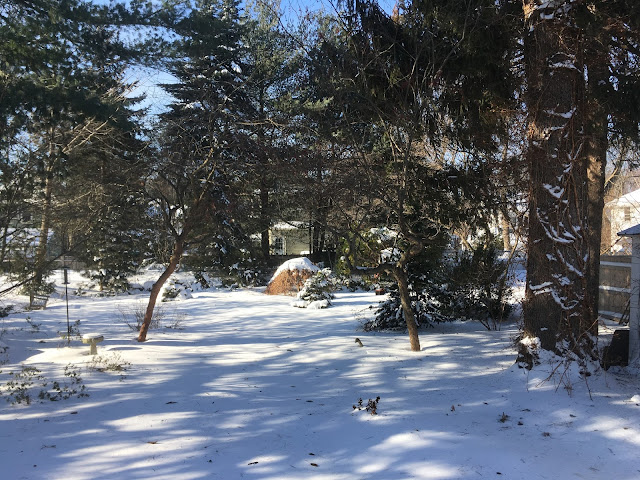 |
| Snow shields the garden from cold damage |
I’m particularly grateful for the blanket of snow this year, because during the summer and fall I went on a planting binge. In April I planted a replacement American persimmon (Diospyros virginiana). In June there was a blue juniper (Juniperus squamata), a yellow-flowering shrub rose (Rose ‘Kolorscape Lemon’), and a fragrant sumac (Rhus aromatica ‘Gro-Low’) for a new bed.
 |
| Blue juniper settling in |
Around the same time, I planted a spicebush (Lindera benzoin), an elderberry (Sambucus canadensis) and an eastern sweetshrub (Calycanthus floridus), native shrubs to fill in the spaces opened up when I cut down hemlocks. For the same spots, at a sale I scooped up a mountain laurel (Kalmia latifolia), a dwarf Alberta spruce (Picea glauca ‘Conica’), two inkberries (Ilex glabra), and an eastern white cedar (Thuja occidentalis) with the promising brand name ‘North Pole.’
 |
| Preparing 'North Pole' for winter with some extra watering |
In early October, I added a semi-dwarf Asian pear (Pyrus pyrifolia) and two honeyberries (Lonicera caerulea). By December, these new trees and shrubs were just recovering from transplant shock and, I hope, sending out some new roots. This winter poses the first severe test of their resilience.
 |
| This bare stick could grow into a 15-foot Asian pear, if it survives the winter |
Readers may recall that I planted my first persimmon in April 2016 before that summer’s severe drought. It didn’t survive. That makes me extra conscious that newly planted trees are vulnerable. Will this band of newcomers make it through to spring? With more than a foot of snow on the ground, their chances are better.
 |
| Second try at an American persimmon |
Temperate zone plants such as my new choices go dormant during the winter. Lengthening nights start the process in autumn, and falling temperatures trigger further readiness. Nutrients are stored in roots, leaves drop, and tissues revise their contents, replacing water with sugars and other chemicals that act as antifreeze so that ice won’t burst cell walls.
By this time of year, trees and shrubs have completed the processes that create endo-dormancy, a state of reduced metabolism that allows them to stay alive and save their resources for spring. When they reach a required chilling duration, they’re ready to switch to eco-dormancy. In this state of readiness, they’re able to respond to environmental conditions by opening buds and sending out leaves and flowers.
During both of these stages, snow acts like a down jacket, its air spaces holding warmth in the ground. Under the snow, roots respire and even grow a little.
Conifers and broadleaf evergreens like my new mountain laurel have a stern challenge in winter, because their foliage continues to lose water to drying winds.
 |
| Leaves held through the winter are vulnerable to cold winds |
That’s why you’ll often see brown leaves on rhododendron branches in spring. Snow cover helps protect evergreens from desiccation. Snow may be a nuisance on paved surfaces, but in the garden, it’s a blessing.
 |
| Flowers open in April thanks to January snow |
No comments:
Post a Comment